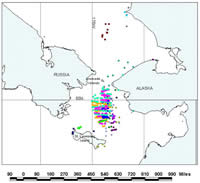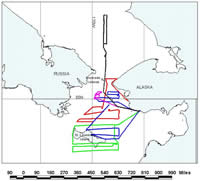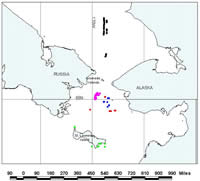What is happening to whales in the Bering Sea?
Dr. Sue Moore
Director, National Marine Mammal Laboratory
NOAA/NMFS/Alaska Fisheries Science Center
Distribution of Whales in the Bering Sea
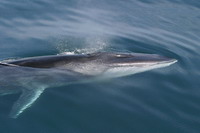 |
Fin Whale Lori Mazzuca, AFSC/Kodiak |
Whales, dolphins and porpoises all belong to the same taxonomic order called cetaceans. Cetacean distribution and abundance in the Bering Sea is poorly described, with even recent reviews of cetaceans' role in the ecosystem reliant on data from historical whaling records. Commercial harvests of baleen whales (mysticetes) were extensive in the North Pacific and Bering Sea, especially between 1835 and 1850 for North Pacific right whales (Balaena japonica) and between 1965 and 1979 for fin whales (Balaenoptera physalus) and humpback whales (Megaptera novaeangliae). The effect of these large-scale removals on the marine ecosystem is largely unknown. Similarly, some species of toothed whales (odontocetes) are sometimes inadvertently killed during commercial fishing operations. Pelagic dolphins and Dall's porpoise were especially vulnerable during high seas driftnet fishing in the North Pacific in the 1980s and, as for mysticetes, the ramifications of these removals are unknown. One reason for this uncertainty is the lack of long-term data on cetacean distribution and estimates of abundance in pelagic environments. Surveys to determine distribution and abundance are costly and therefore, often confined either to coastal waters where logistics are practical or to areas of the ocean where marine mammal mortality associated with commercial fishing is particularly high. The pelagic waters of the Bering Sea do not meet either criteria so are comparatively under-sampled for cetaceans.
The opportunistic sighting of a small group of North Pacific right whales on 30 July 1996 on the western edge of Bristol Bay1 led to: 1) a focused program of research on these critically endangered whales2 and 2) the deployment of trained marine mammal observers on fishery stock assessment cruises in the Bering Sea3. The results of these efforts has been development of a catalogue of individual-specific photos of North Pacific right whales, and first-ever estimates of abundance and distribution plots for cetaceans in the eastern and central Bering Sea. Fin whales were the most common large whale, and Dall's porpoise the most common small cetacean in both regions. Of note, fin whale distribution was strongly associated with the shelf break (200 m isobath) and estimates of abundance were nearly five times higher in the central than in the eastern Bering Sea region. Clearly, additional surveys, with concomitant assessment of cetacean prey, are required to better define the role of cetaceans in the Bering Sea ecosystem. Such multi-disciplinary surveys are the goal of future research.
Response to Climate Change
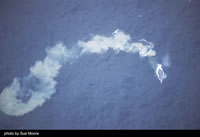 |
| Gray whale trailing mud plume as it surfaces from a feeding bout |
Climate warming has resulted in extreme seasonal retreats and thinning of sea ice in the western Arctic. The reduction in sea ice has obvious and immediate ramifications on ice-obligated marine mammal species such as polar bears, walruses and ice seals. However, other less obvious effects of warming on Arctic and sub-Arctic marine communities are difficult to discern. Gray whales, due to their unique benthic foraging capability and reliance on dense prey aggregations, may provide a clear link between atmospheric forcing and the pelagic-benthic coupling processes required to support high secondary productivity. To explore this link, a 5-day aerial survey was conducted over the Chirikov Basin in the northern Bering Sea during summer 20024. In the 1980s, the Chirikov Basin was a prime gray whale feeding area with an extremely productive benthic prey community. However, no comprehensive assessments of whale or prey distribution and abundance have occurred since then. The 2002 survey for gray whales revealed restricted distribution in the Basin and a 3 to17-fold decline in sighting rates compared to the 1980s. Many more whales were seen north of Bering Strait, where the sighting rate was 0.49 whales/km compared to only 0.03 whales/km in the Basin. Available measurements of biomass suggest a downturn in prey abundance that began as early as 1983, when estimates of gray whale population size were still increasing. These data, and reports of hundreds of gray whales feeding in the south-central and northwest Chukchi Sea and southeast of Kodiak Island in the Gulf of Alaska, suggest that benthic communities in the Chirikov Basin may no longer support large aggregations of whales and that gray whales are foraging elsewhere. Since multi-decade, time series data are available for the Chirikov Basin, long-term studies of this area are encouraged to investigate predator-prey responses to changing ocean climate.
References:
[1] Goddard, P.D. and D.J. Rugh. 1998. A group of right whales seen in the Bering Sea in July 1996. Marine Mammal Science 14(2): 344-349.
[2] LeDuc, R.G., W.L. Perryman, J.W. Gilpatrick Jr., J. Hyde, C. Stinchcomb, J.V. Carretta and R.L. Brownell Jr. 2001. A note on recent surveys for right whales in the southeastern Bering Sea. Journal of Cetacean Research and Management (Special Issue) 2: 287-290.
[3] Moore, S.E., J.M. Waite, N.A. Friday and T. Honkalehto. 2002. Cetacean distribution and relative abundance on the central-eastern and the southeastern Bering Sea shelf with reference to oceanographic domains. Progress in Oceanography 55: 249-261.
[4] Moore, S.E., J.M. Grebmeier and J.R. Davies. 2003. Gray whale distribution relative to forage habitat in the northern Bering Sea: current conditions and retrospective summary. Canadian Journal of Zoology 81: 734-742.
Additional Information:

